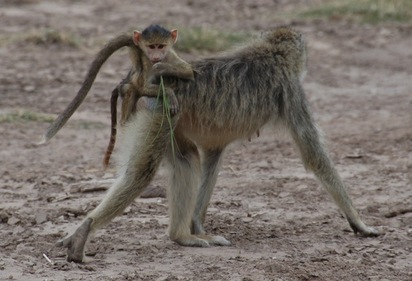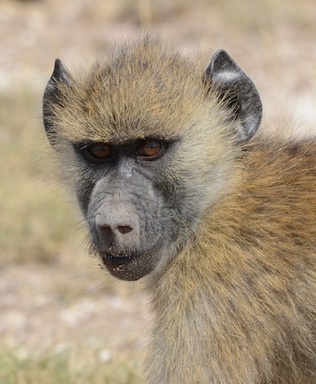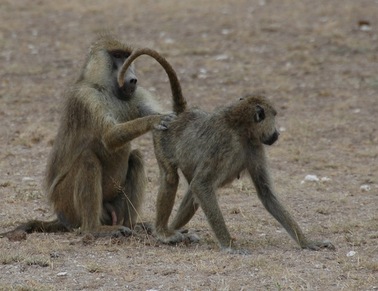Life histories

From the cradle to the grave
Life stages, from conception to death, vary greatly in duration, even from one mammal to another. Species that mature quickly usually have short lifetimes and produce large litters at frequent intervals; they have what is sometimes termed ‘fast life histories’. Similarly, those that mature slowly usually live long and have only one or two young at a time. Within each order of mammals, such as rodents or primates, larger species tend to have ‘slower’ life histories, smaller ones have ‘quicker’ life styles. But orders of mammals also differ. Primates, including baboons and humans, have ‘slower’ life histories than do other mammals of similar size. So a species’ body size and the type of mammal it is together tend to tell us what type of life history that species will have. Baboons, as fairly large primates, have relatively slow life-histories. However, even within a species, factors such as food can have a significant effect on the speed of maturation, length of life, and even the number of young born at a time; good nutrition speeds up maturation, somewhat increases litter size, and also extends lifespan.
Gestation and Birth
A baboon female gives birth to just a single young after about 178 days, a little less than six months. That’s two-thirds as long as human gestation. Baboons, like humans and many other primates, tend to give birth at night. The baboon group is on the move traveling and foraging for food on the ground most of the day, whereas it is settled in the greater safety of trees or cliffs at night. We have sometimes observed births; the mother shows visible signs of labor only for about 1-2 hours and usually stays somewhat hidden during that time. She assists the infant as it is born, pulls it up to her chest, usually consumes the placenta and cuts the umbilical cord, and then cleans the wet infant. Twins are rare; in Amboseli we’ve only recorded the birth of twins twice among over 400 births. In one case, both twins were stillborn, and only one of the twins lived beyond two weeks in the other. If you read more about the environmental demands on baboon mothers and infants in the wild, you won’t be too surprised that twins are rare and can’t usually survive.
Infants
Newborn baboon infants, like human infants, are very dependent for survival on continuous care by an adult. For a baboon infant, the care usually comes primarily from its mother who is the infant’s only source of nutrition, milk, until the infant can forage on its own. An infant is about two pounds at birth, about 7% of its mothers’ size. Although the newborn baboon infant is not able to run about on its own, it is born with a very strong gripping ability. This strong grip enables the infant to help its mother carry it all day; the infant clings to the fur on its mother’s belly. Its mother can then carry the infant while she stays within the safety of her traveling group and forages for food, which requires use of all four limbs. As a bonus, the infant clings in a perfect position to suckle whenever it chooses to! That’s particularly important because primate milk is not very rich, unlike that of seals or caribou, or even cows. Primate infants need to drink frequently throughout the day to obtain enough nutrition to survive and grow, which means staying close to mom. After only a few weeks, though, an infant can climb about, somewhat awkwardly at first, and it immediately begins playing and exploring foods. By three or four months, the infant begins to get a bit of food on its own, starting with easy foods like flowers and berries and fresh green grass blades. By the time an infant is a year old, it is gathering almost all of its own food, though it still goes to its mother for an occasional drink, especially while sleeping huddled with her in the trees at night. Although a baboon infant often seeks independence from an early age, more independence than its mother may be ready to give, a mother’s effort to wean her infant from her milk is usually a long, protracted affair that elicits protest and even dramatic tantrums by her infant [38, 51].

Weaning and becoming independent
Between a baboon infant’s first and second birthday, it makes the transition from infancy to being a juvenile. By the time a baboon is two years old, it usually has a younger sibling and is pretty much on its own most of the time--feeding, exploring, and doing lots of playing with other juveniles--though it usually sleeps with an older sister or brother, or perhaps its mother and her new infant, at night.
Keeping up with the group and obtaining enough food to support about a pound of growth every three months takes up most of the day. Nonetheless, young baboons always find some time for play and grooming, especially during the rainy season and other months when food is abundant and easy to access. Infants first practice grooming their mothers’ fur, and young juveniles who still want a drink when they are being weaned sometimes use grooming as a way to get close to the nipple and get that gulp or two of milk! Although both males and females seem to be able to groom at the same age, females generally groom, and groom their mothers, more than males do from an early age, a portend of differences between older males and females. Both males and females play in a great diversity of ways, swinging from vines, playing games of chase, sometimes with an object such as a large vulture feather, and engaging in rough and tumble wrestling. At first, males and females play similarly and together, but by the time they are about three years old, the males generally play more roughly and the females begin to spend more time grooming. Individuals vary a lot, though, and we are seeking to understand some of the origins and consequences of this variability [73, 84, 93, 94, 102, 121].
Adolescence
The differences in juvenile male and female play patterns that begin to develop at around three years become more and more pronounced as the lives of adolescent males and females begin to diverge.
A major difference between males and females is in the pattern and timing of their sexual development [125 , 41 ,91]. Between four and five years of age, female baboons reach menarche - that is, they begin to experience regular reproductive cycles, each lasting about a month as in humans. For newly adolescent females, the first cycles are intense periods of change and development. A young female becomes very interested in adult males, and will spend a rather large proportion of her time approaching males back-end first, looking anxiously over her shoulder as she "presents" to the male. Males exhibit a distinct lack of interest in these young adolescent females - a common sight in a baboon group is a male gazing off into the distance as a young and hesitant female is backing towards him, glancing over her shoulder with apparent tension and excitement. This ritual may be repeated again and again over the course of a female's first cycles, but usually within about five months, males begin to respond rather differently when she approaches them. Instead of indifference or a friendly reassuring gesture, males begin to respond with sexual behaviors. Soon, males begin to approach the adolescent females instead of the other way around, and when this occurs, females usually experience their first sexual consortship. Sexual consortships are periods of close following of a fertile female by a male. Most copulation occurs in the context of consortships, and a male actively works to prevent other males from coming near the female he is consorting with. Within six months or so of her first consortship, a female conceives her first offspring, leaving adolescence behind and entering the adult world.

While their female peers are experiencing their first sexual cycles and moving towards adulthood, males are entering a period of rapid growth known as an adolescent growth spurt, during which they more than double the growth rate they experienced as juveniles. Males enter this growth spurt at about the same size as their female peers, but they come out of it several years later at literally twice the size of adult females (adult females weigh 12 to 15 kg, adult males weigh 23 to 30 kg). Soon after their growth spurt begins, males go through puberty and their testes enlarge, but until they reach adult size two or more years later, these adolescent males remain reproductively inactive, largely because adult males restrict the access to fertile females.
Adulthood
Males and the challenge of dispersal. Adulthood presents different challenges for males and females. Most important among these differences is that, while females remain in the social group in which they were born, males disperse and seek other groups in which to live [124]. In Amboseli, the first dispersal usually occurs at around the time a male reaches full adult size (8 years or so), but age at first dispersal varies quite a lot both in Amboseli and across other baboon populations. Some males leave before puberty, although this is rare in Amboseli. In most baboon populations, all males leave by the time reach adulthood, but in Amboseli some males remain in their group of birth well into adulthood, and even reproduce there. This was a rather surprising finding. It's generally thought that the function of dispersal is to reduce the risk of inbreeding - mating with close relatives - which can have serious consequences for the offspring produced by such matings.
Dispersal is an inherently risky proposition for males, because males have to locate other social groups while avoiding predators and finding food and water, without the protection or help of a social group. In spite of this, males disperse not only from their group of birth, but repeatedly throughout their lives, on average once every two years in Amboseli. Dispersal patterns vary greatly however, not only in the timing of the first dispersal, but in the frequency of subsequent dispersals. Why is this? We think that the challenges associated with dispersal go a long way towards explaining these differences. In rich habitats, there will generally be lots of baboon groups. This means that males dispersing in rich habitats find both baboons and food more easily than males dispersing in drier, more variable habitats like Amboseli (see the current research on Life in a Changing Environment). Further, there are many predators in Amboseli, adding to the risk of dispersal. As a result, dispersing males in Amboseli may have to spend a substantial amount of time alone, looking for a social group and missing out on mating opportunities. More importantly, dispersing males experience a substantial risk of death, up to 10 times higher than the risk they face while living in a group.
How do males balance the risks? If a male risks death by leaving their group of birth, and risk inbreeding by remaining in it, what tips the balance in favor of remaining or dispersing? Why do some males decide to leave and others to stay? And why do males who have successfully found a second group to live in, where they don't risk inbreeding, ever disperse again? Individual differences in personality undoubtedly account for some of the difference, but a good deal of it has to do with where the best mating opportunities are. Males appear to pay close attention to whether or not they are likely to get opportunities to consort with females in the group they're living in. If a males has few opportunities to consort with females, either because most of the females in the group are pregnant or have babies, or because the male hiimself just isn't very successful at obtaining consortships in that group, then he is likely to leave and seek another social group with more females or in which he is more competitive at getting them to mate with him [124, 138].

Females and families. Unlike males, females have the luxury (or the constraint, depending on your point of view) of remaining in their group of birth, among their relatives, throughout their lives. This difference has profound consequences for the social lives of males and females. For males, social lives are initially centered on finding and obtaining mating opportunities with females, and later may expand focus to include developing relationships with those females and their children, some of whom might be the male's own offspring. For females, social lives are centered, throughout their lives, on the network of family in which they live. Initially their social relationships will center on sisters and mothers. But females produce their first offspring at about six years of age, and produce a single offspring about every 18 to 24 months throughout their lives. Thus, their social focus quickly expands to include offspring.
Social relationships, particularly with family, are important to females. They spend up to 10% of their day socializing, which may not seem like much unless you realize that they spend up to 75% of their day just making a living (travelling and foraging) [129]. That means that they choose to spend almost half of their "free" time directly interacting with others, and the remainder of it resting. These interactions take many forms and are important in a variety of ways (see Baboon Social Life: Family, Friends and Foes for an explanation of how we know this).

Aging
The journey into old age is another one that males and females experience differently. For many females, the social milieu and the day-to-day realities of their lives do not change greatly with age. Their intimate knowledge of the environment and home range of their social group may mean that they increasingly take the lead in finding rare seasonal foods or water sources. Their families may be growing and their family network changing as their mothers and sisters age and die while their daughters and nieces grow and attain adulthood. For females from small families, and females who have lost many offspring to predators and disease, age may bring increasing social isolation as their age mates die from predation or old age But in general, except for that fact that in old age their daughters usually rise in rank above them [143], the tenor of the lives of most females does not change dramatically with age.
Males experience more pronounced changes in their lives as they age. Because male dominance rank depends on fighting ability, males drop in rank as they age. This means that they obtain fewer sexual consortships overall, and they rely more on social connections with other males and with females to obtain what consortships they do get. For older males, social relationships with other males can result in the formation of cooperative coalitions against young, high-ranking males in sexual consortships with females. These coalitions are often the best strategy that an older male has for gaining opportunities to consort. Another strategy that males pursue involves cultivating relationships with females. By grooming a female and supporting her and her offspring in fights, males may increase the chance of consorting with her when she cycles [91, 122, 124, 126].
Menopause
Menopause is the term used for the endpoint of reproductive senescence and reproductive potential in humans. It is given a special term, unlike senescence in other bodily functions, because in humans the reproductive system in females stops functioning at a considerably younger age than the ages at which other systems fail. Most mammals in the wild die before they exhibit extensive evidence of reproductive or other senescence, so much of our information about senescence comes from animals that live in captivity, as pets or in zoos or research centers. Interestingly, the evidence thus far indicates that baboons and most or all other primates tend to reproduce well into old age and into the time other systems begin to fail, although menstrual cycles and births become more irregular in old age--sometime in the early 20's for baboon females.
